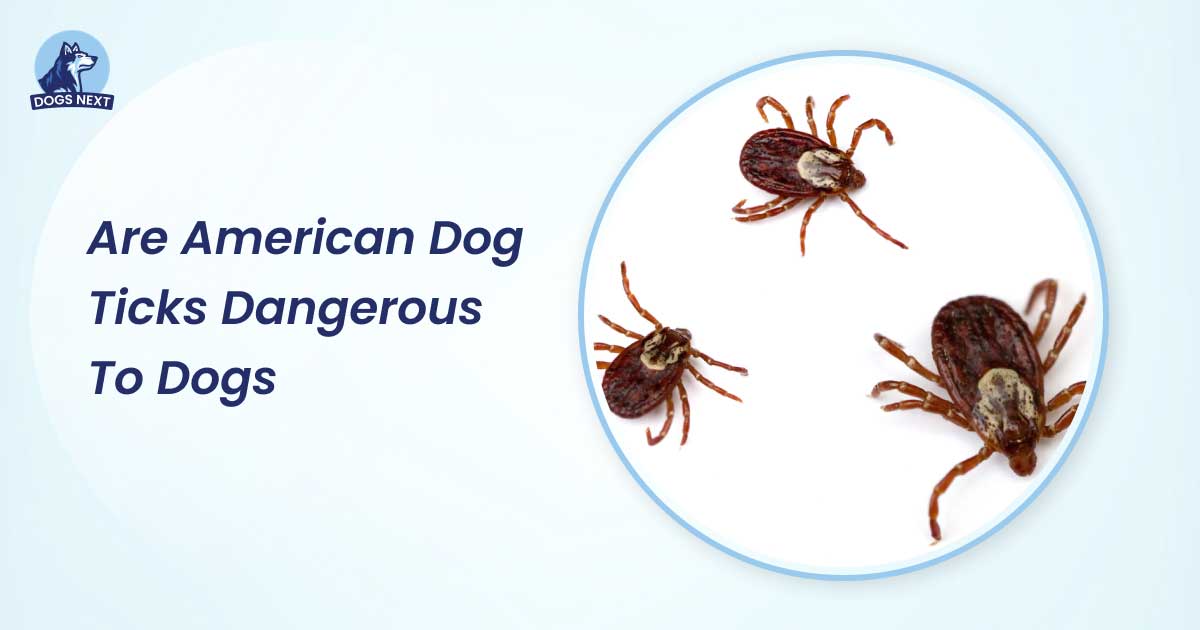American Dog Ticks are dangerous to dogs. They can transmit diseases like Rocky Mountain Spotted Fever and cause tick paralysis.
American Dog Ticks pose a significant threat to canine health. These ticks can transmit serious diseases, including Rocky Mountain Spotted Fever, which can be fatal if not treated promptly. Tick paralysis is another risk, which occurs when a tick’s saliva affects the dog’s nervous system, leading to muscle weakness or paralysis.
Regular tick prevention and prompt removal are crucial in protecting your dog. Check your dog frequently for ticks, especially after outdoor activities. Use veterinarian-recommended tick preventatives and consult your vet for the best tick control strategy. Keeping your dog safe from ticks ensures a healthier and happier life for your furry friend.
Potential Health Risks Of American Dog Ticks
American dog ticks are more than just a nuisance; they pose significant health risks to dogs. These tiny pests can transmit a variety of diseases that can cause severe illness in your furry friend. Understanding the potential health risks of American dog ticks is crucial for every pet owner.
Common Diseases
American dog ticks are carriers of several dangerous diseases that can affect dogs. Here are some of the most common:
- Rocky Mountain Spotted Fever (RMSF): This disease is caused by the bacterium Rickettsia rickettsii. It can lead to fever, joint pain, and even death if not treated promptly.
- Canine Ehrlichiosis: This is another tick-borne disease caused by the bacterium Ehrlichia canis. Symptoms include fever, lethargy, and weight loss.
- Tularemia: Also known as “rabbit fever,” this disease is caused by the bacterium Francisella tularensis. It can cause fever, swollen lymph nodes, and ulcers.
These diseases can be severe and even fatal. Early detection and prompt treatment are essential for the well-being of your dog.
Symptoms To Watch For In Infected Dogs
Recognizing the symptoms of tick-borne diseases can save your dog’s life. Here are some signs to watch for:
- Fever: A sudden high fever is a common symptom of many tick-borne diseases.
- Lethargy: If your dog seems unusually tired or weak, it could be a sign of infection.
- Loss of Appetite: Dogs suffering from tick-borne diseases often refuse to eat.
- Swollen Lymph Nodes: Check for swelling around the neck, shoulders, and legs.
- Joint Pain: Limping or stiffness can indicate joint pain caused by infection.
If you notice any of these symptoms, contact your veterinarian immediately. Early treatment can prevent serious complications and ensure a full recovery for your dog.
Life Cycle Of The American Dog Tick
American Dog Ticks can pose serious dangers to dogs. Understanding the life cycle of these ticks is crucial for prevention and control. The American Dog Tick goes through four stages: egg, larva, nymph, and adult. Each stage has unique characteristics and behaviors.
How They Attach And Feed
American Dog Ticks attach to dogs to feed on their blood. They have specialized mouthparts that allow them to pierce the skin and anchor themselves firmly. These mouthparts make it difficult for the tick to be easily removed.
Here’s a detailed look at their feeding process:
- Larval Stage: Newly hatched larvae, also known as seed ticks, have six legs and are tiny. They seek small mammals or birds to feed on.
- Nymph Stage: After feeding, larvae molt into nymphs with eight legs. Nymphs are slightly larger and seek larger hosts.
- Adult Stage: Adult ticks are the largest and target dogs and other large mammals. Females need a blood meal to lay eggs.
Ticks can feed for several days. During this time, they may transmit diseases such as Rocky Mountain spotted fever.
| Life Stage | Number of Legs | Common Hosts |
|---|---|---|
| Larva | 6 | Small mammals, birds |
| Nymph | 8 | Medium-sized mammals |
| Adult | 8 | Dogs, large mammals |
Understanding their feeding process helps in identifying and removing ticks promptly.
The Importance Of Timely Removal
Removing American Dog Ticks quickly is crucial. The longer they stay attached, the higher the risk of disease transmission. Prompt removal reduces the chance of infections and other complications.
Follow these steps for safe tick removal:
- Use fine-tipped tweezers to grasp the tick as close to the skin’s surface as possible.
- Pull upward with steady, even pressure. Avoid twisting or jerking the tick, which can cause mouthparts to break off and remain in the skin.
- Clean the bite area and your hands with rubbing alcohol, an iodine scrub, or soap and water.
- Dispose of the tick by submerging it in alcohol, placing it in a sealed bag/container, wrapping it tightly in tape, or flushing it down the toilet.
Monitor the bite area for signs of infection such as redness, swelling, or a rash. Consult a veterinarian if your dog shows any symptoms of illness.
Timely tick removal can prevent the spread of diseases and ensure your dog stays healthy.
Prevention Methods To Protect Dogs
American dog ticks can pose serious health risks to dogs. They can transmit diseases like Rocky Mountain spotted fever and tularemia. Protecting your dog from these threats is crucial. Learn about effective prevention methods to keep your dog safe from ticks.
Tick Control Products
Effective tick control products are essential in safeguarding your dog. These products come in various forms:
- Spot-on Treatments: Applied directly to your dog’s skin. They kill ticks on contact.
- Tick Collars: These release chemicals that repel ticks. They provide long-lasting protection.
- Oral Medications: Given as pills. They work from the inside out, killing ticks that bite your dog.
- Tick Sprays: Used for immediate relief. They can be applied to your dog’s coat before outdoor activities.
Consult your veterinarian to choose the best product for your dog. Always follow the instructions on the label for safe and effective use.
| Product Type | Application Frequency | Advantages |
|---|---|---|
| Spot-on Treatments | Monthly | Easy to apply, long-lasting |
| Tick Collars | Every 6-8 months | Long-lasting, water-resistant |
| Oral Medications | Monthly | Effective, no residue |
| Tick Sprays | As needed | Immediate relief, versatile |
Tips For Reducing Tick Exposure During Outdoor Activities
Reducing tick exposure during outdoor activities is vital. Follow these tips to keep your dog safe:
- Stick to Clear Paths: Avoid tall grass and bushy areas. Ticks often hide in these spots.
- Perform Regular Tick Checks: Check your dog for ticks after outdoor activities. Pay attention to the neck, ears, and underbelly.
- Use Tick Repellents: Apply tick repellents before heading outdoors. Ensure the product is safe for dogs.
- Maintain Your Yard: Keep your lawn mowed and remove leaf litter. This reduces tick habitats.
- Dress Your Dog: Use protective clothing, like tick-repellent vests. They can provide an extra layer of protection.
These measures can significantly reduce your dog’s risk of tick bites. Staying vigilant and proactive is key to keeping your furry friend safe.
What To Do If Your Dog Is Bitten By A Tick
American dog ticks pose a threat to dogs by spreading diseases like Rocky Mountain spotted fever. If your dog gets bitten by a tick, immediate action is crucial. Below, learn the steps for safe tick removal and when to consult a veterinarian to ensure your pet’s health.
Steps For Safe Tick Removal
Removing a tick from your dog safely is essential. Follow these steps to ensure you do it correctly:
- Gather Supplies: You need tweezers, rubbing alcohol, gloves, and a small container.
- Wear Gloves: Put on gloves to avoid direct contact with the tick.
- Use Tweezers: Grasp the tick close to your dog’s skin.
- Pull Gently: Pull the tick out slowly and steadily. Avoid twisting or jerking.
- Disinfect the Area: Clean the bite area with rubbing alcohol.
- Save the Tick: Place the tick in a container for identification if needed.
Refer to the table below for quick reference:
| Step | Action |
|---|---|
| 1 | Gather supplies |
| 2 | Wear gloves |
| 3 | Use tweezers |
| 4 | Pull gently |
| 5 | Disinfect the area |
| 6 | Save the tick |
When To Consult A Veterinarian
After removing the tick, observe your dog for signs of illness. Consult a veterinarian if you notice any of the following symptoms:
- Fever: Elevated body temperature can indicate an infection.
- Lethargy: Unusual tiredness or lack of energy.
- Loss of Appetite: Refusal to eat or drink.
- Swelling: Redness or swelling around the bite area.
- Difficulty Walking: Limping or stiffness.
- Vomiting: Frequent vomiting may signal a problem.
If any of these symptoms appear, contact your veterinarian promptly. Early intervention can prevent serious complications.
For further guidance, refer to the table below:
| Symptom | Action |
|---|---|
| Fever | Consult a vet |
| Lethargy | Consult a vet |
| Loss of Appetite | Consult a vet |
| Swelling | Consult a vet |
| Difficulty Walking | Consult a vet |
| Vomiting | Consult a vet |
Frequently Asked Questions
What Are American Dog Ticks?
American dog ticks are parasitic arachnids that feed on the blood of dogs and other animals. They are found in grassy and wooded areas.
Are American Dog Ticks Harmful To Dogs?
Yes, American dog ticks can transmit diseases like Rocky Mountain spotted fever. They can also cause irritation and anemia in dogs.
How Can I Identify American Dog Ticks?
American dog ticks are reddish-brown with white or yellow markings. They are about the size of a sesame seed when unfed.
How Do I Remove An American Dog Tick?
Use fine-tipped tweezers to grasp the tick close to the skin. Pull upward with steady pressure. Clean the bite area afterward.
Conclusion
American dog ticks can pose serious health risks to dogs. Regular checks and preventive measures are crucial. Protecting your pet from ticks helps prevent diseases like Lyme disease and Rocky Mountain spotted fever. Always consult your veterinarian for advice on the best tick prevention methods for your furry friend.

I’m David, an expert contributor and writer, with two furry friends of my own, I know the challenges of raising and caring for dogs. From training to nutrition and health, my goal is to provide valuable insights and advice to help create strong bonds and happy, healthy lives. Find me in Twitter.




